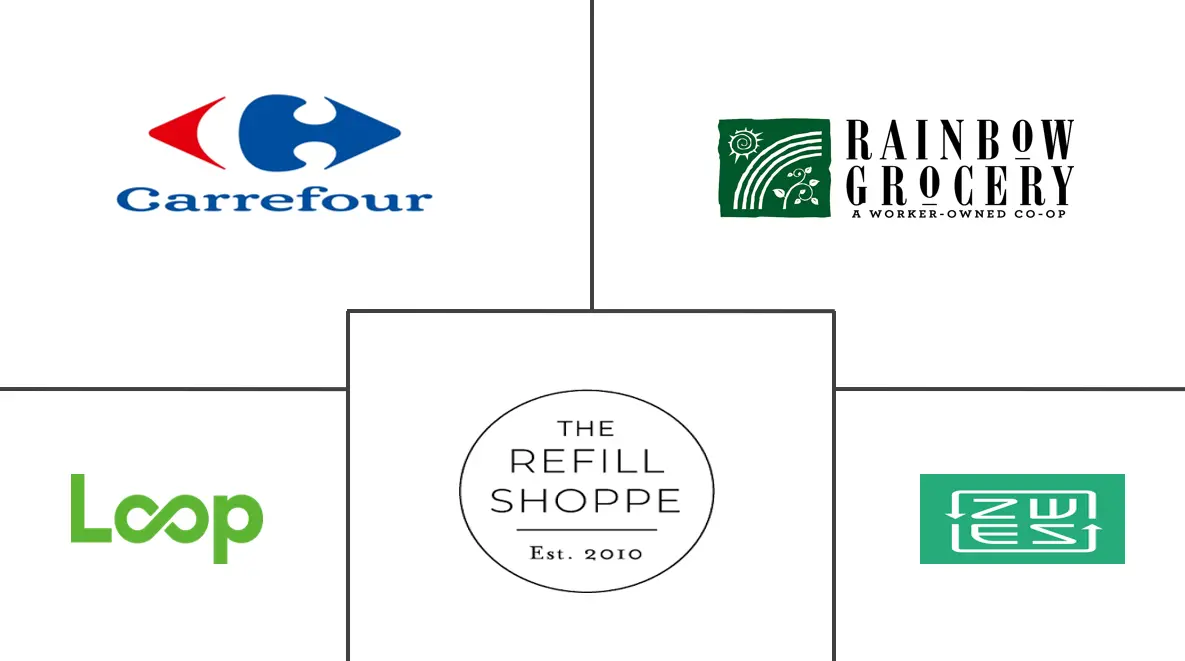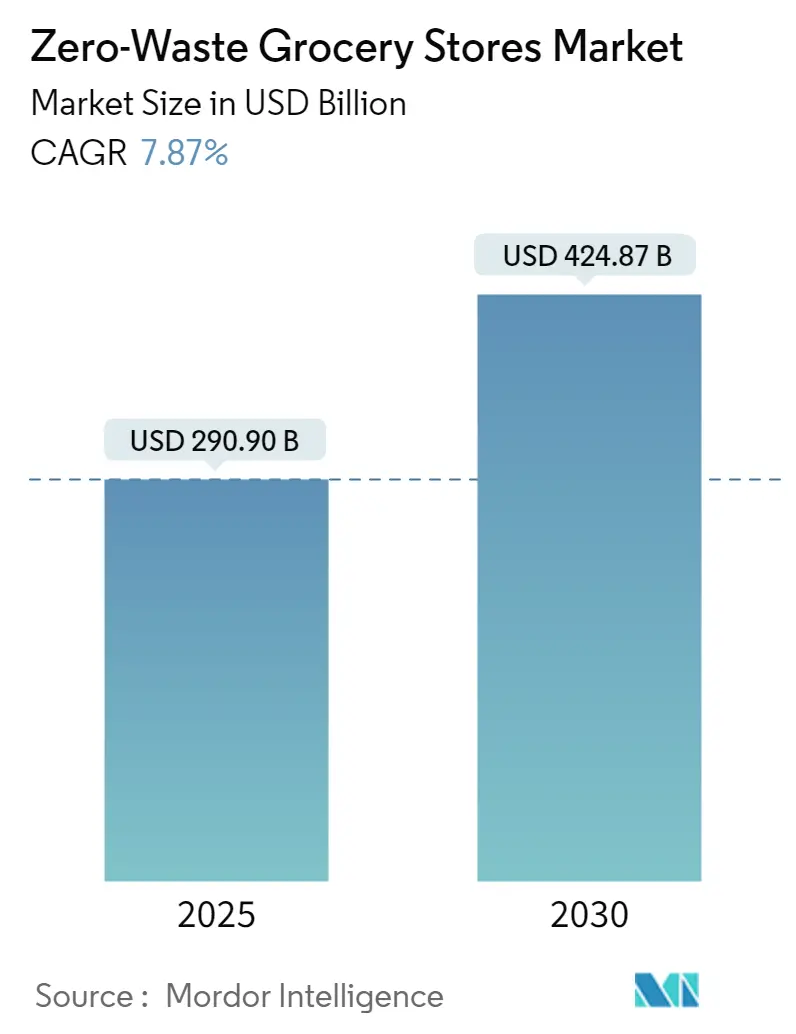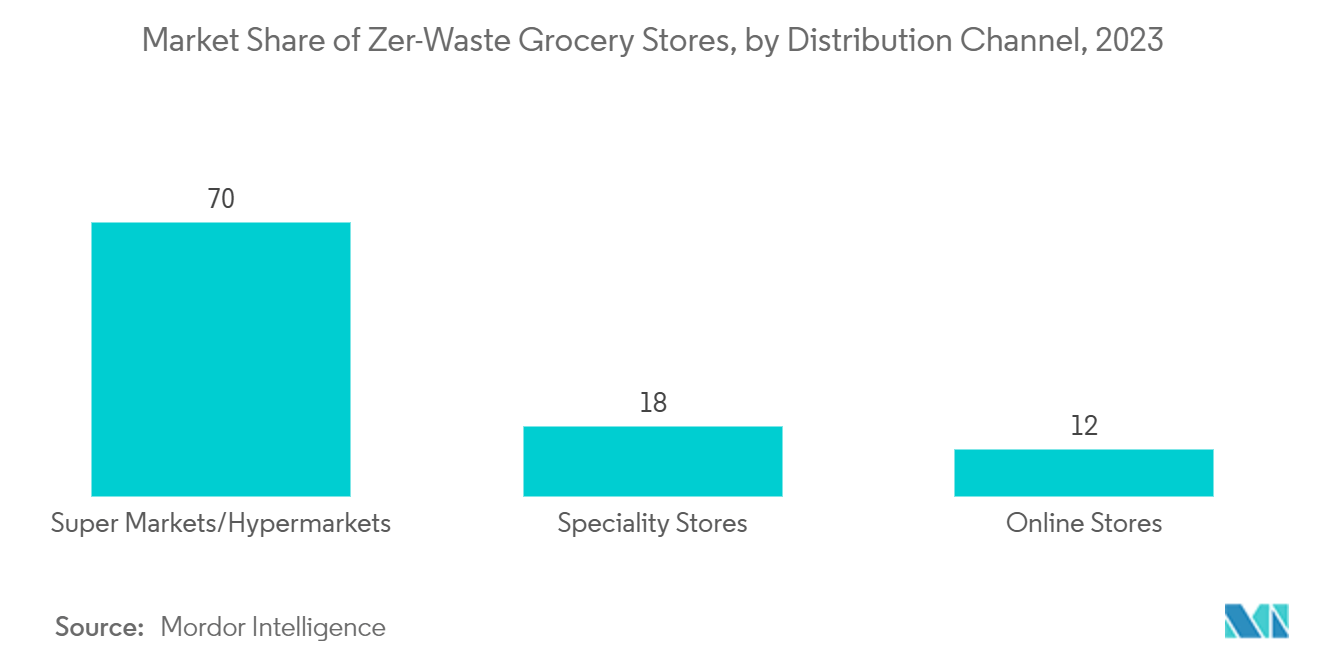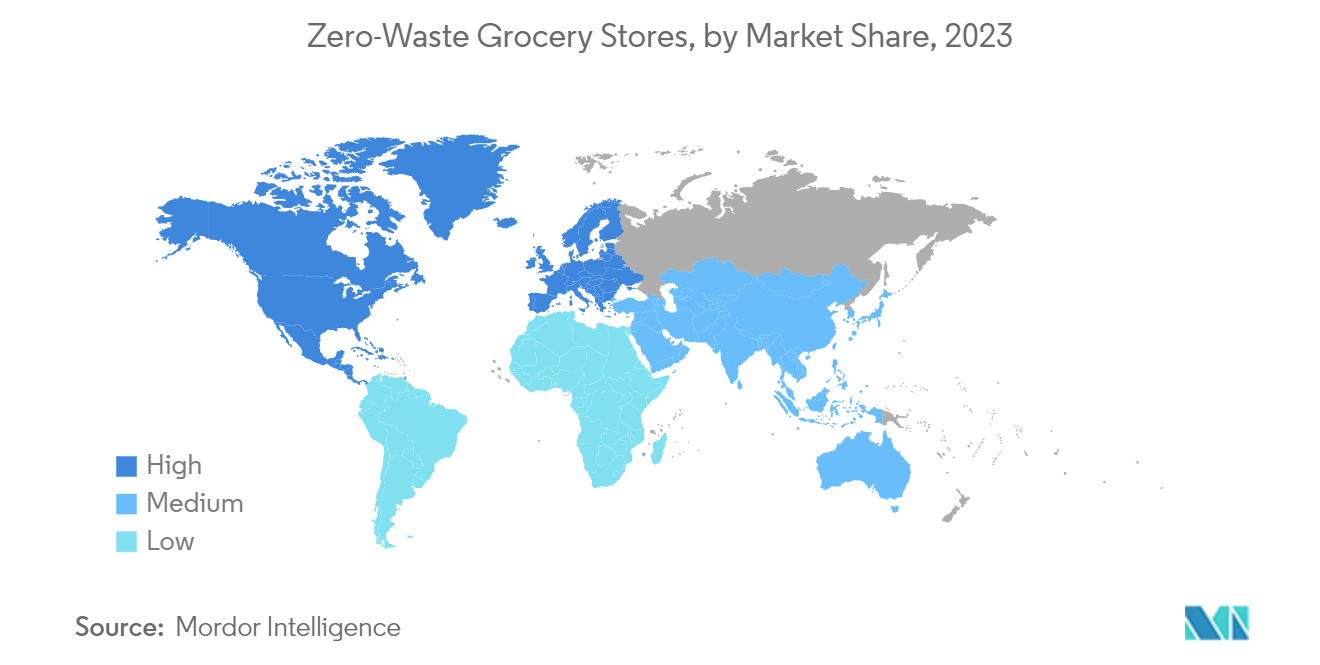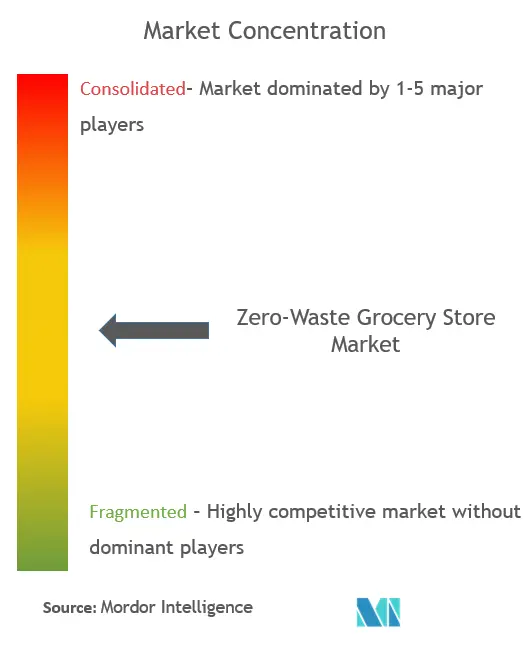Zero-Waste Grocery Stores Market Analysis
The Zero-Waste Grocery Stores Market size is estimated at USD 290.90 billion in 2025, and is expected to reach USD 424.87 billion by 2030, at a CAGR of 7.87% during the forecast period (2025-2030).
Zero waste stores are reshaping the retail landscape, offering customers a plastic and packaging-free shopping experience. These stores primarily focus on refill and bulk options, encouraging shoppers to bring their containers for food, personal care, and cleaning products. The global count of such stores has surpassed, with many new ones seeking crowdfunding on online platforms. Beyond being packaging-free, zero-waste stores often champion a holistic, sustainable ethos, showcasing a range of local and organic products. This distinctive approach sets them apart from traditional retailers, carving a niche for themselves.
Zero-waste grocery stores, at the forefront of the sustainable shopping movement, are making a statement not just in concept but also in practice. Their impact is evident, not only in their waste reduction efforts but also in catalyzing responses from major retail grocery chains. Despite accounting for just 10% of food outlets, US supermarkets add massive billions of dollars to the total yearly food waste. Furthermore, food packaging alone constitutes 23% of all landfill waste.
Zero-Waste Grocery Stores Market Trends
Zero-Waste Grocery Stores Proliferate in Supermarkets and Hypermarkets, Propelling Growth
Supermarkets and hypermarkets, known for their diverse product offerings, have seen a surge in the inclusion of zero-waste grocery stores within their distribution channels. These stores present a unique opportunity to combat single-use plastic by offering alternatives to traditional packaging, such as plastic wraps, bags, and straws. Despite this, traditional supermarkets and hypermarkets remain popular shopping destinations, especially for fresh produce. Notably, supermarkets that transitioned away from single-use plastic packaging witnessed a remarkable surge in vegetable sales. Beyond the environmental benefits, going zero-waste also translates to significant cost savings for businesses, cutting down on labor, energy, and disposal expenses.
The online retail channel is poised for the swiftest growth during the forecast period. This momentum is fueled by the global uptick in online shopping, indicating a clear shift in consumer behavior.
North America Leading the Market
As environmental consciousness rises, so does the scrutiny of the repercussions of plastic waste. Individuals in the United States and Canada are spearheading the movement toward sustainability. Bolstering this shift, governments in the region have rolled out initiatives to manage environmental waste, setting the stage for significant market growth in the coming years. While it's evident that stores are actively reducing waste in their operations, major retail supermarket chains are also embracing this trend.
Supermarkets alone contribute to 10% of food waste produced annually in the United States. Additionally, food packaging constitutes a significant 23% of landfill waste. Through the "10x20×30 Initiative," spearheaded by major players like Kea Food, Kroger, and Walmart, the goal is to slash food waste over the next decade. By 2030, these leading retailers aim to collaborate with at least 20 suppliers each, furthering their waste reduction efforts. As the push for sustainable shopping gains momentum, zero-waste stores are set to become the new norm.
Zero-Waste Grocery Stores Industry Overview
The zero-waste grocery store market exhibits a semi-consolidated landscape, with only a handful of options available presently. The report delves into the competitive dynamics, highlighting key players such as Rainbow Grocery, Loop, Zero Waste Eco Store, Carrefour, and The Refill Shoppe.
Zero-Waste Grocery Stores Market Leaders
-
Rainbow Grocery
-
Loop
-
Carrefour
-
The Refill Shoppe
-
Zero Waste Eco Store
- *Disclaimer: Major Players sorted in no particular order
Zero-Waste Grocery Stores Market News
- July 2024: Carrefour, a prominent supermarket chain, partnered with GreenYellow, a key player in France's energy transition, to install solar panels across its national store network. This joint effort focuses on installing photovoltaic units in the parking lots of 350 hypermarkets and supermarkets in France, Spain, and Brazil.
- November 2023: Carrefour into a new partnership with Czech Group JIP Retail. All stores of the chain’s network started selling a large range of Carrefour products.
- January 2023: Good Earth Natural Foods partnered with USEFULL to reduce single-use packaging waste. As part of its commitment to sustainability, Good Earth began offering USEFULL’s tech-enabled, insulated stainless steel cups in its in-store cafes.
Zero-Waste Grocery Stores Industry Segmentation
Zero-waste refers to eliminating garbage by reusing, composting, and recycling as much as possible. In the grocery aisle, zero-waste shopping means bringing reusable bags and containers, selecting foods without plastic packaging, or purchasing items in glass or metal containers that can easily be repurposed. The zero-waste grocery store market is segmented by distribution channel and geography. By distribution channel, the market is segmented into supermarkets/hypermarkets, specialty stores, and online stores. By geography, the market is segmented into North America, Europe, Asia-Pacific, South America, and the Middle East and Africa. The report offers market size and forecasts for the zero-waste grocery stores market in value (USD) for all the above segments.
| By Distribution Channel | Supermarkets/Hypermarkets | ||
| Speciality Stores | |||
| Online Stores | |||
| By Geography | North America | United States | |
| Canada | |||
| Rest of North America | |||
| Europe | United Kingdom | ||
| Germany | |||
| France | |||
| Russia | |||
| Italy | |||
| Spain | |||
| Rest of Europe | |||
| Asia-Pacific | India | ||
| China | |||
| Japan | |||
| Australia | |||
| Rest of Asia-Pacific | |||
| South America | Brazil | ||
| Argentina | |||
| Rest of South America | |||
| Middle East and Africa | United Arab Emirates | ||
| South Africa | |||
| Rest of Middle East and Africa | |||
Zero-Waste Grocery Stores Market Research FAQs
How big is the Zero-Waste Grocery Stores Market?
The Zero-Waste Grocery Stores Market size is expected to reach USD 290.90 billion in 2025 and grow at a CAGR of 7.87% to reach USD 424.87 billion by 2030.
What is the current Zero-Waste Grocery Stores Market size?
In 2025, the Zero-Waste Grocery Stores Market size is expected to reach USD 290.90 billion.
Who are the key players in Zero-Waste Grocery Stores Market?
Rainbow Grocery, Loop, Carrefour, The Refill Shoppe and Zero Waste Eco Store are the major companies operating in the Zero-Waste Grocery Stores Market.
Which is the fastest growing region in Zero-Waste Grocery Stores Market?
Asia Pacific is estimated to grow at the highest CAGR over the forecast period (2025-2030).
Which region has the biggest share in Zero-Waste Grocery Stores Market?
In 2025, the North America accounts for the largest market share in Zero-Waste Grocery Stores Market.
What years does this Zero-Waste Grocery Stores Market cover, and what was the market size in 2024?
In 2024, the Zero-Waste Grocery Stores Market size was estimated at USD 268.01 billion. The report covers the Zero-Waste Grocery Stores Market historical market size for years: 2020, 2021, 2022, 2023 and 2024. The report also forecasts the Zero-Waste Grocery Stores Market size for years: 2025, 2026, 2027, 2028, 2029 and 2030.
Zero-Waste Grocery Stores Industry Report
Statistics for the 2025 Zero-Waste Grocery Stores market share, size and revenue growth rate, created by Mordor Intelligence™ Industry Reports. Zero-Waste Grocery Stores analysis includes a market forecast outlook for 2025 to 2030 and historical overview. Get a sample of this industry analysis as a free report PDF download.

